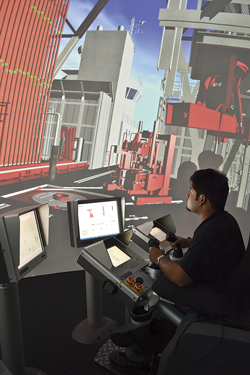Drilling advances
Vol. 233 No. 9
As the now-extended regulations within the U.S. Safety and Environmental Management Systems (SEMS) approach their first anniversary as official “commandments,” “documented core competency” reigns as the mandate du jour for nearly everyone connected with the offshore oil and gas industry. Not surprisingly, the federal edict has spawned a training cottage industry, as companies scurry to present proof that their rig hands are proficient in all things HSE. The U.S. Bureau of Safety and Environmental Enforcement (BSEE) made the once-voluntary SEMS regulations mandatory on Nov. 15, 2011, for all operators and, now officially, contractors and service companies working in federal waters. The sweeping SEMS rules require companies to document that their on-site personnel are fully compliant with extremely in-depth HSE protocols. To no one’s surprise last month, BSEE extended the SEMS reach by reaffirming its earlier announced intention to hold contractors and service companies as accountable as operators for HSE infractions that they may induce. If a BSEE inspector finds a problem, the operator will be cited first, but if it is determined that the contractor or service company played any role, they, too, will face the federal wrath. With that, it seems that every discipline on the rig, except maybe the caterers, can be blamed for HSE bloopers. The reaffirmation raised few, if any, eyebrows, as most everyone knew full well that contractors and service companies would not be left off the hook, and, for the past year, have been training accordingly. Training offerings. In January, PEC Premier added a SEMS module as part of its training curriculum for the operator-driven SafeGulf offshore safety initiative. To meet the added contractor requirements of SafeGulf, which was established years before the new federal rules were enacted, PEC now includes SEMS modules in both its one-day Basic Safety Orientation and three-day Core Compliance safety training courses. PEC, which provides standardized safety and skills training to the contractor workforce, also teamed with Moxie Media to develop a SEMS awareness module with an associated compliance test that is available as a DVD or online. The module includes a dissection of the 13 components of SEMS, as well as new contractor requirements. As for the drilling crews, the International Association of Drilling Contractors (IADC) naturally was one of the first to react to the SEMS rules. In tandem with an Offshore Operators Committee (OOC) task force and the API-sanctioned Center for Offshore Safety (COS) in Houston, IADC developed what it calls the SEMS Toolkit to assist operators and contractors in assessing readiness to meet the requirements, including the mandatory contents of an operator’s SEMS plan. As training companies continue to push SEMS compliance modules, the larger service companies, have elected to keep instruction in-house. A case-in-point is Boots & Coots, a division of Halliburton, which operates a large Learning Center in Houma, La., where one of the primary functions is an exhaustive core compliance curriculum that includes both hands-on and classroom instruction. Simulating rig experience. In Katy, Texas, just outside of Houston, Aker Solutions has taken hands-on training to an entirely new dimension with highly advanced simulation technology designed to emulate a rig-based environment. There, twin simulators, using advanced 3D visualization technology, went into operation in January and have since been used to train both employees and clients in how to deliver safer, more efficient drilling operations, and increase rig uptime. In development long before the new rules were enacted, the simulators are not yet being used for SEMS-specific training. The twin 240° domed simulators are the centerpieces of Aker Solutions’ 9,800-sq-ft training facility. According to the company, the dome-shaped screen, in combination with actual drilling control systems software, creates a realistic environment mimicking that of a specific rig. Each targeted rig is recreated as a virtual asset, including all associated equipment and control systems. “A realistic, real-time visualization of drilling operations enables rig operators to learn to make better and faster decisions,” the company says. The elaborate server systems comprise 88 individual servers, delivering sufficient capacity to run the two simulators simultaneously. Scotty Hughlett, Aker Solutions Drilling Technologies’ senior director of drilling lifecycle services, says 76 courses have been completed between January and August, with the remainder of the year shaping up to be equally as busy. “We have 20 courses booked through December 2012 and receive more bookings weekly,” he said “We have five classrooms and two simulators, and if they are all in session we can teach up to 76 students a day.” Hughlett said Aker Solutions is investigating the possibility of including SEMS and well control courses as part of its overall training portfolio.
|
- Coiled tubing drilling’s role in the energy transition (March 2024)
- Using data to create new completion efficiencies (February 2024)
- Digital tool kit enhances real-time decision-making to improve drilling efficiency and performance (February 2024)
- E&P outside the U.S. maintains a disciplined pace (February 2024)
- Prices and governmental policies combine to stymie Canadian upstream growth (February 2024)
- U.S. operators reduce activity as crude prices plunge (February 2024)
- Applying ultra-deep LWD resistivity technology successfully in a SAGD operation (May 2019)
- Adoption of wireless intelligent completions advances (May 2019)
- Majors double down as takeaway crunch eases (April 2019)
- What’s new in well logging and formation evaluation (April 2019)
- Qualification of a 20,000-psi subsea BOP: A collaborative approach (February 2019)
- ConocoPhillips’ Greg Leveille sees rapid trajectory of technical advancement continuing (February 2019)





